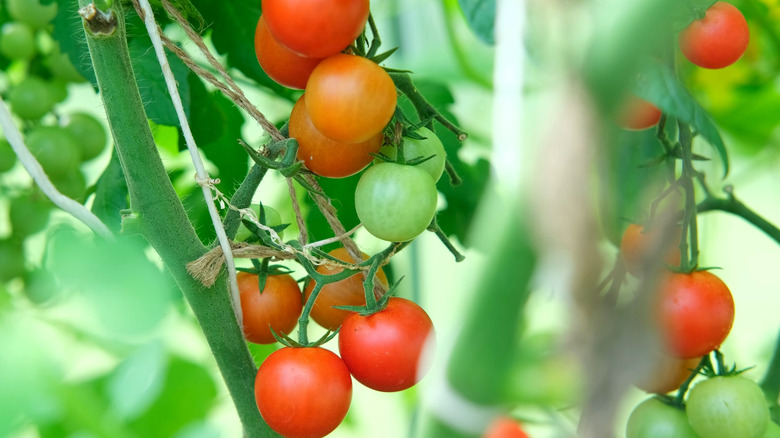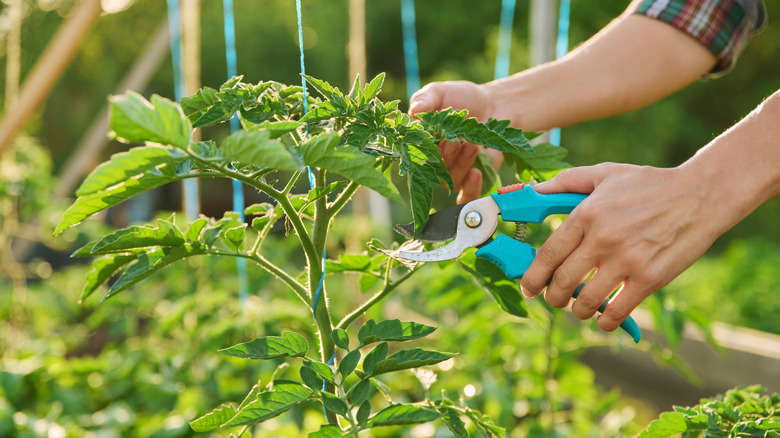The Simple String Technique For Growing Strong & Healthy Tomato Plants
Among the garden staples, tomato plants are some of the fastest growers. While this can be a beneficial trait, it also means that they need support early on to prevent breakage, disease, and crowding. Store-bought cages might seem like a garden go-to, but outfitting your garden with one for each plant can get pricey fast — especially if you're growing more than a handful of tomato plants in a given season. Fortunately, there's a simpler, more affordable solution. By using basic materials like garden twine and PVC piping, you can build a sturdy support system that trains your plants to grow upright on their own. It's a flexible, easy to build, cost-effective method that can quickly transform a tomato garden.
Most tomatoes aren't built to support their own weight, especially once they start producing fruit. Their vines are soft and flexible, which makes them excellent growers but not great at staying upright. Without help, the stems often bend and snap. That's where the problems start! Fruit touching the ground is more likely to rot, attract pests, or pick up soil-borne diseases. Dense, collapsed vines also block sunlight and can trap moisture underneath, which can lead to mildew and poor fruit development. Supporting the plant from the beginning with a simple string trellis helps to prevent this outcome. It keeps that plant growing tall, exposes it to more sunlight, and improves airflow around the base of the plant. Healthier plants produce more — and better — tomatoes. So while this method may seem simple, it is packed with surprising benefits for any gardener looking to promote healthier plant growth from their tomatoes. It's one of the best ways to support your tomatoes to keep them healthy, without breaking the budget on a garden overhaul.
Using string to grow healthy tomatoes
One of the easiest ways to use this method is by building a simple arch out of PVC piping and string. Start by securing your piping into the ground using a couple of cinderblocks and rebar that is buried in the soil. The PVC should slide directly over the piece of rebar to create a strong, budget-friendly garden trellis that will provide enough height to promote healthy tomato growth. If you don't want to purchase rebar, or you already have a garden fence installed, you can use a block of 4-by-4 wood to secure your PVC piping. Simply drill a hole into the top of the block, attach it to your garden beds, and insert the piping. Once the arch is secure, tie a piece of string to the base of each tomato plant, ensuring that it doesn't get too tight around the plant. As you move the string upwards, weave it around the stalk of your tomatoes to ensure that it stays upright as it grows. Secure the piece of string to the newly-constructed archways. Just like that, you have a budget-friendly way to ensure that your tomatoes continually grow upright.
If you're missing a couple of materials, don't rush out to grab them. There are plenty of ways to customize this DIY with materials that you may have laying around. While PVC piping may be the easiest material for creating archways, you can also use a simple piece of scrap wood to instantly up your gardening game by creating a framework for your string to hang. It can work with metal, plastic, or wood, so don't feel like you can't get creative!
Training and pruning tomatoes for vertical growth
Once your tomatoes are happily growing on their string trellis, the next step is to keep them growing straight and healthy all season long. As they grow, give the main stem a quick twist around the string every couple of days to ensure that the plant moves upwards. You can also use a few garden essentials like soft plant ties, Velcro garden tape, or reusable clips to loosely secure your tomatoes in place. The key word is loosely: Tomato stems can thicken quickly and any ties that are too tight may cut into your plant, leading to potential disease or rotting. Keep an eye out for any specific branches or areas that seem to be leaning away from the rest of the plant, as these can quickly become hard to move once they are blooming with fruit.
You'll also want to stay on top of your pruning, but only if your plants are indeterminate. Tomatoes like to send out "suckers," which are little shoots that appear in the space between the main stem and a leaf. If you let them grow out completely, they will eventually turn into whole branches, which can make the plant bushy, block sunlight, and steal necessary energy away from fruit production. About once a week, pinch or snip any suckers on your plant — keeping only the first one just below the lowest cluster of fruit if you want a second main stem. While you're at it, you can remove any lower leaves that may be touching the soil, as this can help to prevent disease. Keeping just the main stem and trimming regularly will make your plant easier to train using a string trellis, healthier overall, and loaded with juicy tomatoes all season.

